Kerala SSLC Physics Previous Question Papers with Answers 2017 are part of Kerala SSLC Physics Previous Year Question Papers with Answers. Here we have given Kerala SSLC Physics Previous Question Papers with Answers 2017.
| Board | SCERT |
| Class | SSLC Class 10 |
| Subject | Physics |
| Category | Kerala SSLC Previous Question Papers |
Kerala SSLC Physics Previous Year Question Papers with Answers 2017 Free Download English Medium
Time Allowed: 1 1/2 hours
Cool off time: 15 Minutes
Maximum Marks: 40
Instructions
- First 15 minutes is cool off time.
- Answer the questions only after reading instructions and questions thoroughly.
- Questions are given in A, B, C, D sections. Write only 4 questions from each section.
- Score allotted for sections A, B, C, D are 1, 2, 3 and 4 respectively.
Questions
SECTION A
Question 1.
Which type of waves are used in Wi-Fi for connecting different devices?
Question 2.
Give the frequency of electric current distributed in our country.
Question 3.
Which radiation is used in night vision camera?
Question 4.
Which of the following property of sound is used in the working of a stethoscope?
(Resonance, echo, Multiple reflection, Forced vibration)
Question 5.
Fill up the blanks after observing the given relation.

SECTION B
Question 6.
The earth pin of a three pin plug is constructed with some special features. Why?
Question 7.
Which part of a power generator is functioning as a stator? Give the advantage of using this part as the stator.
Question 8.
Give the functions of an electronic ballast used in modem Fluorescent Lamp.
Question 9.
Write any four methods used in the construction of big halls to increase the clarity of sound.
Question 10.
What is known as Brown energy?
SECTION C
Question 11.
a. What do you mean by biomass?
b. Throwing biomass carelessly can cause atmospheric pollution. Explain why?
c. State how the biomass in a biogas plant is converted into biogas.
Question 12.
a. Write an instance in which Tyndal effect is observed,
b. Explain how Tyndal effect is produced.
Question 13.
Refer the figure given below.

a. Represent graphically the input and output voltage.
b. Name the process taking place in the above circuit.
Question 14.
a. Write the name of the gases that causes global warming.
b. Give the steps to be adopted for reducing global warming.
Question 15.
Star connection is wrongly depicted in the following figure.
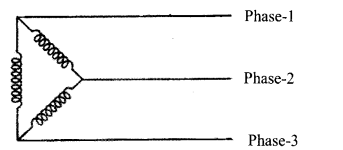
a. Redraw the correct figure.
b. What is the potential difference between the neutral line and the earth?
SECTION D
Question 16.
a. Describe an experiment to show the scattering of white light.
Give the details of:
- apparatus required
- procedure
- observations
b. Based on this experiment explain why the atmosphere of moon appears dark.
Question 17.
An arrangement of two solenoids over a soft iron core kept without contacting each other is given below. Observe the figure.
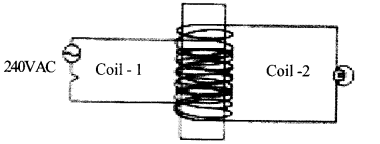
Based on this figure answer the following questions.
a. Name the process in which current is produced in the second coil, when the circuit is switched on.
b. What are the factors affecting the induced e.m.f?
c. Can we get continuous light from the bulb when the AC source is replaced by a DC source.Why?
Question 18.
The time-temperature graph of a liquid heated in a vessel is shown below. Answer the following based on this graph.
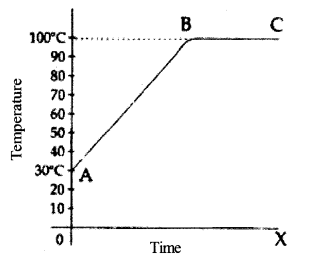
a. Give the boiling point of the liquid.
b. For which process the heat supplied to the liquid from B to C is used.
c. Name the vaporization process that takes place only at the boiling point of a liquid.
d. What do you mean by latent heat of vaporization?
Question 19.
The graph of sound wave propagation is given below. Analyse the graph and answer the questions.

a. Name the physical quantity whose amplitude is represented on the Y – axis.
b. If the frequency of the wave is 300 Hz, calculate the speed of the wave.
c. Explain how sound is propagated through air.
Question 20.
Go through the circuit given below:
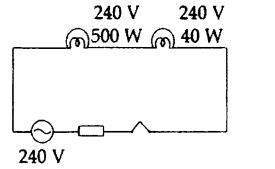
a. Which lamp will be brighter when the circuit is switched on? Justify your answer.
b. What will be the amperage of the fuse in the circuit?
Answers
Answer 1.
Radio waves
Answer 2.
50 Hz
Answer 3.
Infrared
Answer 4.
Multiple reflection
Answer 5.
Photo diode
Answer 6.
The earth pin is thick and long. As it is long it first comes in contact with the earth. Similarly to loses the contact with the earth only at the end. As if thick it offers less resistance. It carries more current than the amount of current coming from the phase.
Answer 7.
Armature
We can avoid rings and graphite brushes when the armature is used as stator. So there is no possibility of producing sparks.
Answer 8.
In a fluorescent lamp, the ballast regulates the current to the lamps and provides sufficient voltage to start the lamps. Without a ballast to limit its current, a fluorescent lamp connected directly to a high voltage power source would rapidly and uncontrollably increase its current draw
Answer 9.
- Make the floor and walls rough
- Hang curtains in the hall
- Use cushions in chairs
- Use sound absorbing materials
Answer 10.
Brown energy is produced from non- renewable sources such as petroleum, coal and nuclear energy.
Answer 11.
a. The body parts of plants and animals are known as biomass.
b. De composition of biomass produce Hydrogen sulphide and methane. Burning of biomass gives personous gas like carbon monoxide, sulphur dioxide etc
c. When biomass is deposited into a biogas plant, biogas is formed by the action of bacteria in the absence of oxygen. Its main constituent is Methane.
Answer 12.
a. Scattering of light in farest due to mist and fog
b. When rays of light pass through a colloidal fluid or suspension, the tiny particles get illuminated due to scattering. Due to this, the path of light is made visible. This phenomenon is called Tyndal effect.
Answer 13.
a. Input voltage vs time
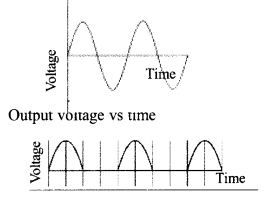
b. Half wave rectification
Answer 14.
a. CFC, Carbon dioxide, Methane, Water vapor etc
b. Use solar energy
Use hydrogen as fuel
Reduce the use of CFC.
Reduce the excessive use of fossil fuels.
Answer 15.
a.

b. Zero
Answer 16.
a. Three fourth of a rectangular vessel is filled with water. Allow light to fall from one side of the vessel.The light emerging from the vessel is focused on a white screen. Sodium thiosulphate is dissolved in water in the beaker. 2g of sodium thiosulphate is required for 1 litre of water. When one or two drops of hydrochloric acid is added to the water in the vessel the light from the torch undergoes scattering. The solution turned sky blue and green, yellow,orange, red colored rays were formed on the screen.

When sodium thiosulphate and Hydro-chloric acid reacts colloidal sulphur is precipitated. Thesize of sulphur particles gradually increases. The particles which have higher wavelength undergoes less scattering . The rate of scattering depends upon the size of particles and wave length.
b. The moon has no appreciable atmosphere to do scattering, so the sky appears dark.
Answer 17.
a. Mutual induction
b. • No. of turns in the secondary
• Input voltage
c. No. Mutual induction doesn’t take place in DC.
Answer 18.
a. 100
b. Change of state
c. Vaporization
d. Latent heat of vaporization (Lv) at a substance is the quantity of heat absorbed by 1 kg of the liquid to change into gaseous state at its boiling point without change in temperature.
Answer 19.
a. Change in pressure
b. v = fλ, = 300×1 = 300m/s
c. Sound propages through air as in the form of longitudinal wave. Particles vibrate in a direction parallel to the direction of propagation parallel to the direction of propagation of wave. Sound requires a medium to propagate. Compression and rare factions are formed.
Answer 20.
a. 40 W power lamp will be brighter. Because
circuit is in series, so which bulb have low power which glow brighter.
b.
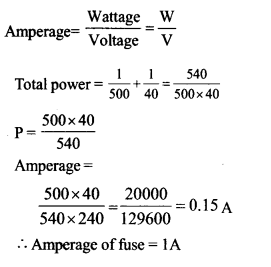
We hope the given Kerala SSLC Physics Previous Question Papers with Answers 2017 will help you. If you have any query regarding Kerala SSLC Physics Previous Question Papers with Answers 2017, drop a comment below and we will get back to you at the earliest.
